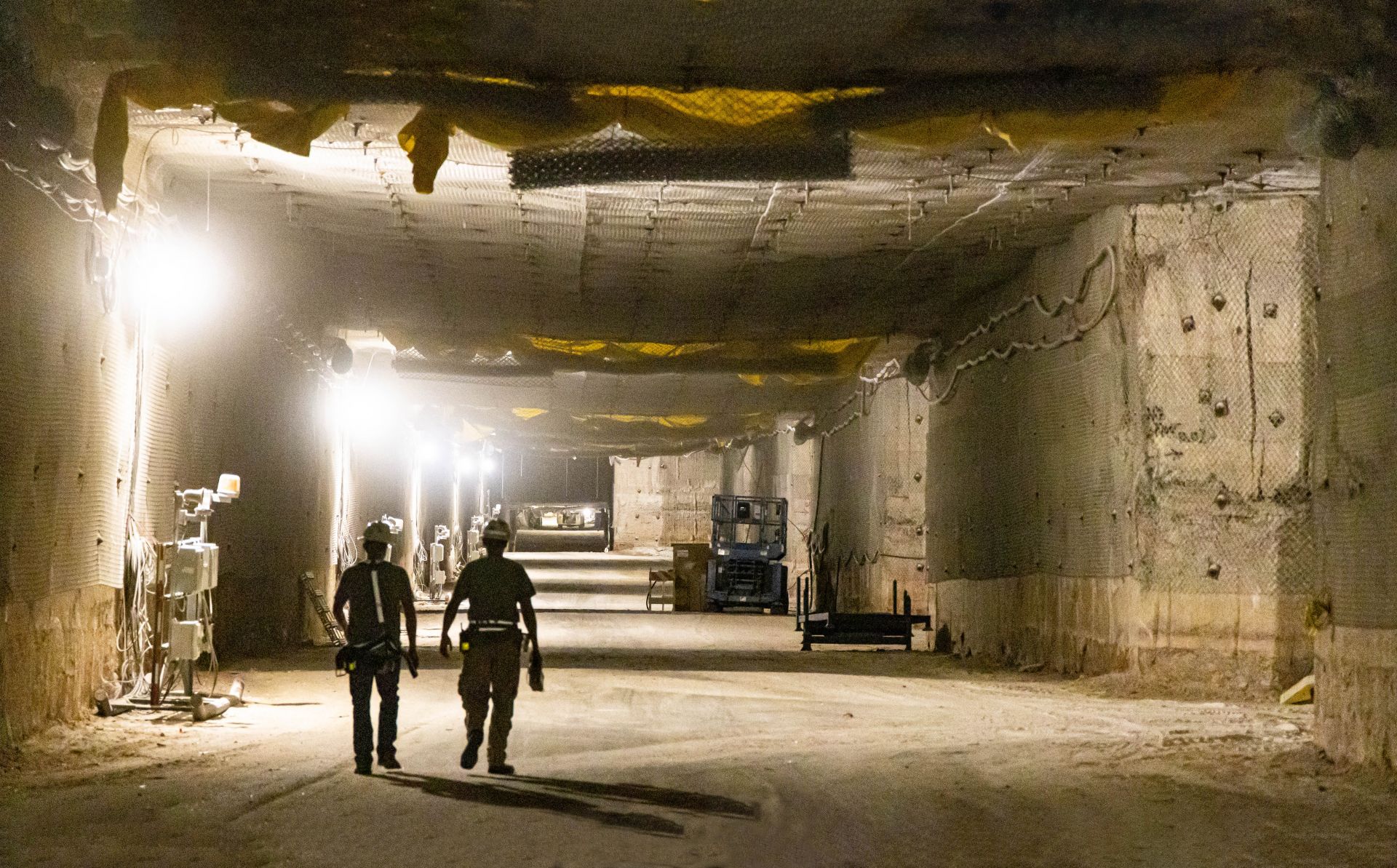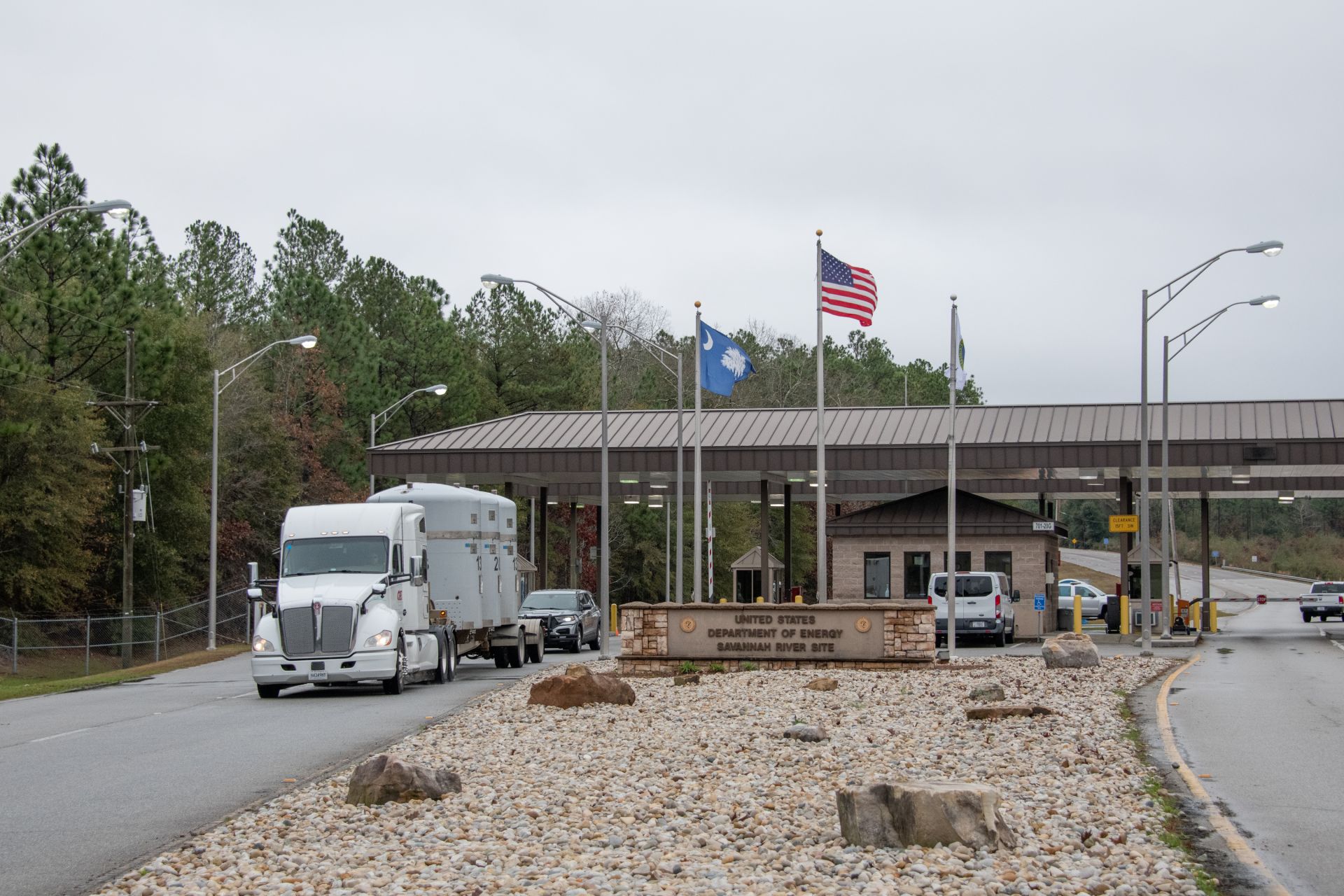The Waste Isolation Pilot Plant in New Mexico. (Photo: DOE)
The Department of Energy today announced a noncompetitive financial assistance cooperative agreement with Southeast New Mexico College, located in Carlsbad, N.M., for educational programs to enhance the knowledge, skills, and abilities of current Waste Isolation Pilot Plant employees while also building and training WIPP’s next-generation workforce.
Work crews use light construction equipment to remove the final pieces of asphalt from one of the pads at the TSA-RE at INL. (Photo: DOE)
The Idaho National Laboratory is moving closer toward closing its largest building—which, at more than 316,000 square feet, could comfortably house a modern U.S. aircraft carrier, according to the Department of Energy.
The Waste Isolation Pilot Plant, near Carlsbad, N.M. (Photo: DOE)
The Department of Energy’s Office of Environmental Management and the New Mexico Environment Department (NMED) have negotiated a settlement on terms to renew the 10-year operating permit for the Waste Isolation Pilot Plant near Carlsbad, N.M. The DOE, along with WIPP’s operating contractor, Salado Isolation Mining Contractors, and the NMED negotiated the settlement with New Mexico stakeholders.
A CAST Specialty Transportation truck delivering TRU waste packages to WIPP. (Photo: DOE)
The Department of Energy’s Waste Isolation Pilot Plant (WIPP) recently marked a milestone after its drivers exceeded 16 million safe miles without a serious accident or injury—equivalent to 33 round trips to the moon or more than 642 trips around the world, the DOE’s Office of Environmental Management announced.
The Galloway is lowered into the utility shaft at WIPP. (Photo: DOE)
Progress continues on a new utility shaft at the Department of Energy’s Waste Isolation Pilot Plant in New Mexico as shaft-sinking crews recently surpassed the midway point at a depth of 1,076 feet. When complete, the full shaft depth will be 2,275 feet, with the team now halfway to the WIPP repository depth of 2,150 feet.
Southeast New Mexico College staff visit the WIPP site. (Photo: WIPP)
Two Department of Energy sites recently announced training partnerships with local technical and community colleges designed to offer students hands-on work experience while building a workforce pipeline to waste management jobs.
The Waste Isolation Pilot Plant in southeastern New Mexico. (Photo: DOE)
Waste management startup Deep Isolation announced that it has entered into a mentor-protégé agreement with Salado Isolation Mining Contractors (SIMCO), the new Bechtel National–led management and operations contractor for the Department of Energy’s Waste Isolation Pilot Plant in New Mexico.
February 17, 2023, 3:03PMRadwaste SolutionsPeter Swift, Michael Apted, Lake Barrett, John Kessler, and Steven Nesbit An electric continuous miner machine cuts out a waste-emplacement panel at the Waste Isolation Pilot Plant salt repository in New Mexico. (Photo: DOE)
Used nuclear fuel and high-level radioactive wastes are by-products of nuclear energy production and other applications of nuclear technology, and the consensus approach to disposing of those wastes safely is to encapsulate them and emplace them in stable geologic formations (geologic repositories) where they will be isolated from people and the environment for very long periods of time. The federal government has established environmental standards for waste isolation that any proposed geologic repository must meet.
In July 2021, the American Nuclear Society established a special committee to consider possibilities for revised generic environmental standards for disposal of spent nuclear fuel and high-level radioactive waste in the United States. The committee developed a number of recommendations, which are contained in a draft report that was to be issued in February for review and comment by stakeholders. The draft report can be found on the ANS website, at ans.org/policy/repositorystandard/.
The committee’s draft recommendations are based on two underlying assumptions. First, that the relevant legislative framework for regulation defined in the Nuclear Waste Policy Act (NWPA) remains unchanged. Specifically, it is assumed that the Environmental Protection Agency will be charged with promulgating environmental standards for disposal and that the Nuclear Regulatory Commission will be charged with reviewing applications for disposal facilities using licensing requirements and criteria consistent with the EPA standards. Second, that existing generic disposal standards will be updated or replaced.
Two workers walk down an underground passageway at the Waste Isolation Pilot Plant transuranic waste repository in New Mexico. (Photo: DOE)
While still lacking a deep geological repository for the permanent disposal of its commercial used nuclear fuel and high-level radioactive waste, the United States does have regulatory standards for geological nuclear waste disposal.
Having been written nearly 40 years ago, however, those standards are outmoded and lack transparency, according to a special committee of the American Nuclear Society, which has released draft recommendations on revising public health and safety standards for future geological repository projects in the United States.
The Waste Isolation Pilot Plant in southeastern New Mexico. (Photo: EPA)
Salado Isolation Mining Contractors (SIMCO), a single-purpose entity comprised of Bechtel National and Los Alamos Technical Associates as a teaming contractor, has assumed responsibility for managing and operating the Waste Isolation Pilot Plant in New Mexico.
The first shipment of downblended surplus plutonium from SRS’s K Area leaves SRS. (Photo: DOE)
The Department of Energy’s National Nuclear Security Administration and Office of Environmental Management have completed the first shipment of downblended surplus plutonium transuranic (TRU) material from the K Area at the Savannah River Site in South Carolina to the Waste Isolation Pilot Plant in New Mexico.
A radiological control technician checks radiation readings on waste containers at WIPP. (Photo: WIPP)
The New Mexico Environment Department (NMED) is adding several conditions to the operating permit for the Department of Energy’s Waste Isolation Pilot Plant (WIPP) near Carlsbad, N.M. The permit changes, which would prioritize the disposal of transuranic (TRU) waste generated in the state and limit the repository’s capacity, are contained in a fact sheet the NMED.
Workers walk down a passageway in Panel 8 at the Waste Isolation Pilot Plant in November. (Photo: DOE)
Employees have begun emplacing defense-related transuranic (TRU) waste in Panel 8 of the Waste Isolation Pilot Plant (WIPP) in New Mexico, the Department of Energy’s Office of Environmental Management (EM) announced in November. TRU waste is permanently disposed of at WIPP in rooms mined in a Permian salt bed 2,150 feet below the surface.
WIPP Blue Team participates in a final briefing before beginning a field contest in a recent national mine rescue competition. (Photo: DOE)
Mine rescue teams from the Department of Energy’s Waste Isolation Pilot Plant (WIPP) finished in the top 15 in competitions at the first-ever joint Coal, Metal, and Nonmetal National Mine Rescue Contest in Lexington, Ky., held on August 7–12.
The Waste Isolation Pilot Plant in southeastern New Mexico.
Reston, Va.-based Tularosa Basin Range Services (TBRS), a single-purpose entity under the umbrella of Bechtel National, has been awarded the 10-year, $3 billion management and operating contract for the Waste Isolation Pilot Plant (WIPP) by the Department of Energy’s Office of Environmental Management (EM). Located near Carlsbad, N.M., WIPP is the DOE’s geologic repository for defense-generated transuranic waste.
The new contract replaces the current WIPP M&O contract held by Nuclear Waste Partnership, which expires on September 30. The contract with TBRS was announced on July 11.




















